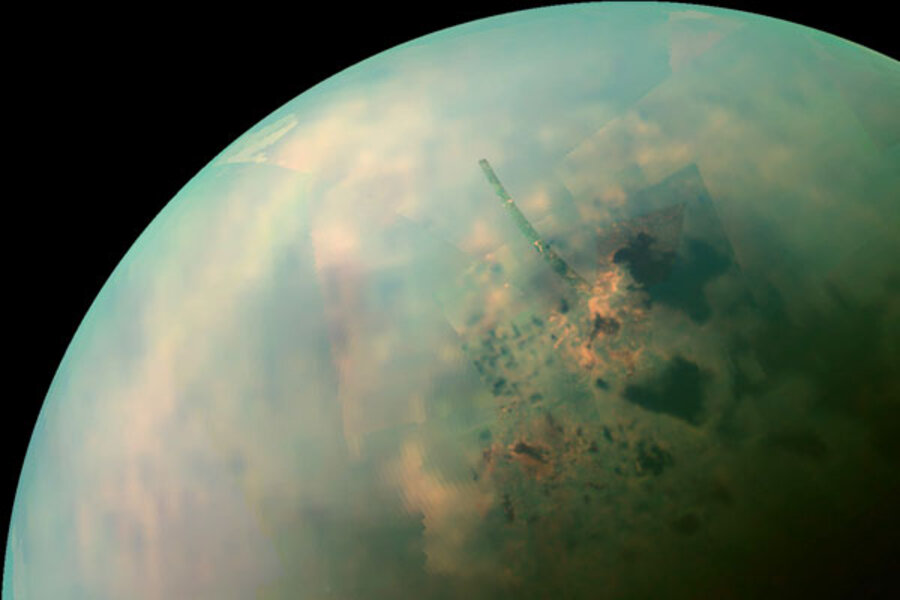Titan's 'Great Salt Lake'? North pole of Saturn moon looks like Utah.
Loading...
Saturn's moon Titan hosts the equivalents of Utah's Bonneville Salt Flats – dried lake beds strewn with compounds left behind by evaporation – over a much wider expanse of the moon's north polar region than previous observations indicated, according to scientists.
New images delivered by NASA's Cassini orbiter also hint that much of Titan's northern region shares a common underlying geology, an observation that could help unravel the mystery of how the lakes formed and why most of the moon's lakes and all of its seas appear near the north pole.
The images mark the first time Cassini has been able to capture the entire north pole, according to Elizabeth Turtle, a planetary scientist at The Johns Hopkins University's Applied Physics Laboratory in Laurel, Md., and a member of the Cassini science team.
The new images, which NASA released Wednesday, “have the potential to change our understanding of the north pole” of Titan, Dr. Turtle says.
Many planetary scientists view Titan as a time capsule, giving them a glimpse of what conditions on Earth might have been like before life emerged. Though Earth is much warmer than Titan, the moon hosts an inventory of organic compounds thought to be similar to those on Earth before life took hold. And the processes shaping Titan's surface – from flowing liquids to volcanic action – mirror those of Earth. Indeed, some astrobiologists posit that simple forms of life may exist below Titan's surface.
Unlike Earth, however, where lakes and ocean basins are filled with water, Titan's lakes are filled with methane and ethane. They fill lakes and seas, fall as rain, and etch channels as they flow along Titan's icy surface. (On the much-warmer Earth, these hydrocarbons appear as gases.)
Since its arrival in the Saturn system in 2004, Cassini has performed 94 close flybys of Titan. Researchers have identified and named three seas and 34 lakes, seven of which are dry lakes.
Two years ago, a team led by University of Idaho planetary scientist Jason Barnes identified what they interpreted as residue from evaporation on the beds of some of Titan's northern dry lakes. On Earth, such residue shows up as deposits of calcium carbonate, calcium sulfate, or salts. On Titan the residue would show up as solid organic compounds,
The new observations cover the entire north polar region and show similar deposits surrounding many of the liquid lakes, much as the Bonneville Salt Flats appear near the Great Salt Lake.
The big surprise came with the observation that most of the lakes appear to share geological underpinnings, Turtle says. This shows up as a vast bright area that spans much of the north polar region. It can be seen only at certain wavelengths of light picked up by the spacecraft's Imaging Science Subsystems cameras.
Getting a better understanding of what that underlying formation is made of could help sort between two leading ideas for how the seas formed, Turtle says.
Researchers take their lead from the shape of the lakes, which tend to be rounded, even if oblong, with steep sides that form crisp boundaries
“If we were looking at Io, we'd identify these as volcanic calderas,” Turtle says, referring to one of Jupiter's largest moons and the most volcanically active object in the solar system.
Indeed, one scenario for the lakes' origins points to volcanism, Titan style, where liquid or gaseous hydrocarbons, and perhaps even water, replace lava as the effluent. Some of the lakes also have a nested look common to some volcanic calderas.
Another scenario envisions underlying geology that liquids can easily dissolve. This would imply that the lake basins formed as sink holes. Researchers are performing lab experiments to see if this possible explanation is plausible, Turtle says.
Researchers are looking forward to Cassini's next close northern flyover, set to take place in about four years.
“If we were able to compare the observations we have now with observations four years from now we could see if things have changed,” Turtle says. “For example, if it rains in one area and the lake levels change there, but not elsewhere, that would suggest that, hydrologically, those areas are disconnected. But if there's an aquifer that connects them all and it rains in one area, they may all change.”
The new images highlight one broad aspect of Cassini's exploration of Titan: It's seldom boring.
“We've been looking at Titan with Cassini for a long time,” Turtle says. “And we're still discovering new things. It's such a complex system that we can be completely surprised, still.”






